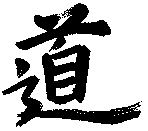 |
Taoism And The Taoist Arts |
|||
Taoist Meditation |
||||
Background & History: The Taoist Arts: |
Meditation is one of the chief tools in the Taoists quest for inner peace. The Chinese word for meditation simply means 'sitting', but Taoist meditation techniques have developed into sophisticated and complex systems designed to have profound mental and physical effects. These techniques have
developed over thousands of years; official records show that breathing exercises
were being practiced as early as 100BC but in fact they go back much further
than that. Belief in the power of correct breathing is a central part of many
spiritual systems and Taoism is no exception. However, unlike most meditation,
much of Taoist meditation is performed while moving (Chi Gung and of course T'ai Chi being the main examples). The aim of Taoist meditation (and meditation in general) is to calm the mind and body to the greatest degree possible. Taoists put great importance on emptiness and stillness, and these qualities are never more important than in meditation. Once the mind is emptied of trivial thoughts, stress vanishes, and when the body is completely relaxed its systems can work at full strength. The chi is strengthened during meditation, and thus there is an important effect on health and general wellbeing. The long term effects of such practices on mental and physical levels can be profound. "No thought enters the mind, no problems arise from
the body, no memories grip the spirit. This overwhelming sense of tranquility
is really all meditation is about. The neutral stillness of the mind renews
the tired soul, and this is regeneration." Many different techniques have evolved throughout the world, and different styles of meditation may have very different methods and aims. Some styles aim to focus the mind on 1 particular thing to cut out all distractions. This is typically a sound (mantra) a picture or image (mandala) a candle flame (as in pranayama meditation) or the persons breathing pattern. A more recent development is to actively think about a positive image or desired situations - known as visualisation. Other styles aim to cut out all thought and make the mind completely still - and this is the approach normally used in Taoist meditation. It can also be useful to use modern meditation or relaxion cds or mp3s. A free guided meditation is available here Additionally, many styles use static postures (eg Indian Yoga) or set movements. Taoists have used both, but movements are more common and are used in Chi Gung and T'ai Chi. The aim is always towards complete physical relaxation. Finally, some form of breath control is common to almost every style; Deep slow abdominal breathing is usually encouraged as an aid to relaxation. Breath control is very important in Taoist meditation. For a simple meditation that anyone can do at home, click here. Looking for books on meditation? Visit the Taoist Bookshop (click here for the UK store.)
|
|||
|
|
||||
